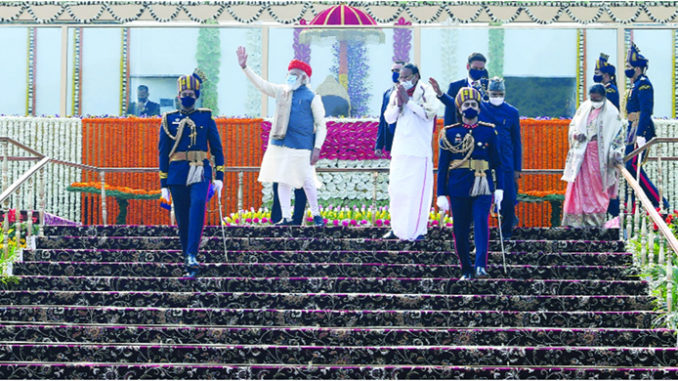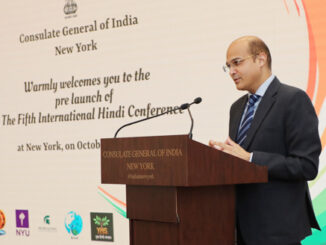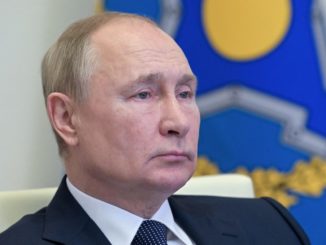
 Every year Republic Day is celebrated in India on 26th January with zeal and enthusiasm. Spectacular parades at Janpath, New Delhi, consisting the Indian National Army and national flag hoisting in various parts of the country are common practices followed on this day. It was this day in history in 1965 when Hindi was declared as the official language of India. This year it will be marked India’s 72th Republic Day.
Every year Republic Day is celebrated in India on 26th January with zeal and enthusiasm. Spectacular parades at Janpath, New Delhi, consisting the Indian National Army and national flag hoisting in various parts of the country are common practices followed on this day. It was this day in history in 1965 when Hindi was declared as the official language of India. This year it will be marked India’s 72th Republic Day.
After attaining independence from the British rule, the new constitution was enrolled by the drafting committee under the deanship of Dr BR Ambedkar. The Indian Constitution came into effect on 26 January 1950, which declared India’s occurrence as an independent republic. January 26th was chosen as the date because on this day in 1930, the Indian National Congress revealed Purna Swaraj, the declaration of India’s independence from the colonial rule.
Republic Day signifies the right spirit of Independent and individual India. The important symbols of the festival include the exhibition of military equipment, the national flag and military equipment.
Mohandas Gandhi struggled through decades of passive resistance before Britain finally accepted Indian independence. Self-rule had been promised during World War II, but after the war triangular negotiations between Gandhi, the British and the Muslim League stalled over whether to partition India along religious lines. Eventually, Lord Mountbatten, the viceroy of India, forced through a compromise plan. On August 15, 1947, the former Mogul Empire was divided into the independent nations of India and Pakistan. Gandhi called the agreement the “noblest act of the British nation,” but religious strife between Hindus and Muslims soon marred his exhilaration. Hundreds of thousands died, including Gandhi, who was assassinated by a Hindu fanatic in January 1948 during a prayer vigil to an area of Muslim-Hindu violence.
Of Gandhi’s death, Indian Prime Minister Jawaharlal Nehru said, “The light has gone out of our lives, and there is darkness everywhere.” However, Nehru, a leader of the Indian struggle for independence and Gandhi’s protege, persisted in his efforts to stabilize India, and by 1949 the religious violence began to subside. In late 1949, an Indian constitution was adopted, and on January 26, 1950, the Republic of India was born.
With universal adult franchise, Nehru hoped to overcome India’s “caste-ridden” society and promote greater gender equality. Elections were to be held at least every five years, and India’s government was modeled after the British parliamentary system. A president would hold the largely ceremonial post of head of state but would be given greater powers in times of emergency. The first president was Rajendra Prasad.
Nehru, who won his first of three subsequent elections in 1952, was faced with staggering challenges. A massively underdeveloped economy and overpopulation contributed to widespread poverty. Nehru also had to force the integration of the former princely states into the Indian union and suppress movements for greater autonomy in states like Punjab.
In his years of struggle against Britain, he always advocated nonviolence but as prime minister sometimes had to stray from this policy. He sent troops into the Portuguese enclaves of Goa and Daman and fought with China over Kashmir and Nepal. He died in 1964 and was succeeded by Lal Bahadur Shastri. Later, Nehru’s only child, Indira Gandhi, served four terms as a controversial prime minister of India.
Republic Day is celebrated all over India with great gratification and joy. It’s a day to honour the Constitution of independent India. National flag hoisting in schools and colleges are regular. Cultural events advocating India’s struggle for freedom is held countrywide. In New Delhi, the national flag is hoisted by the President of India at India Gate. The gloriest of parades takes place at Rajpath, New Delhi. The parade is conducted by the Indian President and is arranged by the Ministry of Defence. Other than displaying its military prowess, the event also promotes India’s diverse culture. The event also colonizes to the martyrs who have sacrificed their lives for the country. The Prime Minister of India honours the martyrs by putting a ringlet at the Amar Jawan Jyoti at India Gate. It’s followed by a 21-gun salute, national flag hoisting, and national anthem. Awards are presented to the brave soldiers in the form of Paramvir Chakra, Ashok Chakra, and Vir Chakra. Even children and general citizens who have displayed courage in times of adversity are honoured with awards.
The winners of gallantry awards salute the President in military jeeps. This is followed by India’s display of its military power. March-past by the armed forces, police, and National Cadet Corps also takes place with the President of India receiving the salute from different regiments. The parade comes to an end when the Indian Air Force fighter jets flypast Janpath. The celebration takes place all over the country, however, Delhi being the capital of India, witnesses the largest of Republic Day celebrations. Live Webcast of the Republic Day Parade is made accessible every year to millions of people who wish to view the parade over the Internet. After the event is over, the exclusive footage is made obtainable as ‘video on demand’.Celebrations, though on a relatively smaller scale, are also held in all state capitals, where the Governor of the state unfurls the flag. Same celebrations are also held at district headquarters, subdivisions, talukas, and panchayats.
After all the celebrations are done the Beating The Retreat takes place which officially denotes the end of Republic Day festivities. All important Government Buildings are beautifully adorned with sparkly lights every evening from 26th to 29th.
Beating the Retreat ceremony is conducted on the evening of January 29, the third day after the Republic Day. The drummers also give a solo performance (known as the Drummer’s Call). The bands march back playing a popular martial tune Saare Jahan Se Achcha. At exactly 6 pm, National Flag is lowered, and the National Anthem is sung, bringing the Republic Day celebrations to a formal end.
Looking Back at India’s First Republic Day
After a spell of extremely cold weather, the morning of 26 January 1950 saw a clear and sunny day, albeit cold, in the capital city of New Delhi. India’s defining moment – the day it freed itself completely from the shackles of colonialism to become a truly sovereign state – had arrived three years after it gained independence.
Leading Up to The Big Day
Between 15 August 1947 and 26 January 1950, the Dominion of India was a constitutional monarchy, with its King still being George VI and two Governor Generals (not Viceroys any longer): Lord Mountbatten (1947-48) and C Rajagopalachari (1948-50). Jawaharlal Nehru held office as Secretary for State (the head of government) of the Union of India throughout this period and governed the country through the Government of India Act (1935).
During this gradual transition phase, the Drafting Committee of the Constituent Assembly (also the interim parliament in this period) was hard at work drafting a constitution for the infant country in the backdrop of lawlessness and bloodshed of the Partition and the beginning of the Kashmir conflict, Mahatma Gandhi’s assassination in 1948 and the complex political integration of 565 princely states with India. Nevertheless, in 1949, the Constituent Assembly finished drafting the world’s longest constitution with a solid foundation of justice, liberty, equality, unity, integrity and democracy as its leading values.
A historic session of the Constituent Assembly was held at the Central Hall of the Parliament House where the Constitution was passed with loud cheering and thumping of desks.
Before the motion and draft Constitution was passed, Dr Rajendra Prasad, the then President of the Constituent Assembly, said:
“Let us launch on this new enterprise of running our Independent Republic with confidence, with truth and non-violence and above all, with heart within and God above.”
It was decided that India would become a truly sovereign state on 26 January 1950, the date chosen for its significance in history when in 1930, the Indian National Congress decided to demand for Purna Swaraj: complete freedom from the British.
Two days before the big day, on 24 January, at a special session of the Constituent Assembly, Dr Rajendra Prasad was elected as the first President of independent India. Jawaharlal Nehru and Sardar Vallabhai Patel became the Prime Minister and Deputy Prime Minister while the Constituent Assembly assumed the role of Nehru’s Central Cabinet. Jana Gana Mana and Vande Mataram officially became the national anthem and song of the country on this day as well. All the cabinet members signed the Constitution, with Dr Rajendra Prasad choosing to do so last and at the very bottom, with a small scribble below Nehru’s name and a line of text.
Last round of preparations for the celebrations of the first Republic Day were set in motion, rehearsals for which had begun since 7 January. On 25 January, the first Indonesian President, Sukarno, arrived in Delhi, warmly greeted by his close friend and ally, Nehru and C Rajagopalachari. He was to be the first Chief Guest at the celebration; a natural fit given the similarity of his ideals with Nehru’s– of democracy and secularism– and the interminable cultural links between the two countries, going back to the time of the Mahabharata.
On Nehru’s request, Delhi University had organised a special convocation to confer an honorary PhD on Sukarno. One moment to be remembered from this ceremony was the riveting role reversal between two of Asia’s charismatic leaders. It was common practice for Nehru to conclude his speeches by shouting Jai Hind. Then, he would say “Louder!” and the crowd would satisfy his demand.
PB Venkata Subramaniam, former Law Secretary, was studying law in the University at that time. Reminiscing about the function, he told V Suryanarayan writing for South Asian Analysis, quoting William Wordsworth: “Bliss was it in that dawn to be alive, but to have been young was very heaven.”
Dr Rajendra Prasad stood in a brilliantly lit, high-domed circular Durbar Hall in Government House (now Rashtrapati Bhavan) delivering a speech, first in Hindi and then in English, shortly after taking oath as India’s first President, replacing the King as India’s head of state. He had spent the morning paying his respects to Mahatma Gandhi at Rajghat.
Six minutes earlier, at 10:18 AM, the last Governor General, C Rajagopalachari, had officially proclaimed India, that is Bharat, to be a Sovereign, Democratic Republic.
“Let us begin with offering our thanks to the Almighty Power that has enabled us to see this day, to the Father of the Nation who showed us and to the world at large his infallible method of Satyagraha and led us on along it to freedom and to the numberless men and women, whose suffering and sacrifice have rendered the attainment of Independence and establishment of this sovereign democratic republic possible,” he continued smilingly with folded hands, in a black achkan, white churidar and a Gandhi cap.
The First Republic Day Parade
Rajpath has become synonymous with Republic Day celebrations 68 years since, that majestic boulevard that runs from the Rashtrapati Bhavan through Vijay Chowk to India Gate. But it was not the venue of the first celebrations in 1950. Beyond India Gate lay, Irwin Amphitheatre (now Major Dhyanchand National Stadium), named after a former Viceroy where 15,000 people had gathered for the big parade, , still nascent compared to the gala it is today.
The new President took a slow, ceremonial ride from Rashtrapati Bhavan with President Sukarno to the amphitheatre in a 35-year-old open state coach bearing the Ashoka Emblem. It was drawn by six Australian horses along the five-mile road to the Amphitheatre, escorted by the President’s bodyguards.
The roads were lined with exuberant crowds with the tricolour in their hands, cheering and chanting “Jai” joined by those peering from neighbouring building roofs and treetops. Dr Prasad greeted them all with his hands folded and a modest but beaming smile.
His arrival at the amphitheatre was marked by a resounding 31-gun salute, solemnising the event as a milestone in India’s “chequered history”: Our first Republic Day celebrations as an independent nation.
Dr Prasad proceeded to take a round of the amphitheatre, this time in a jeep, while saluting the 3,000 armed forces that had gathered there, after which he hoisted the tricolour, our national flag for the very first time. Another memorable speech by him was in the offing.





Be the first to comment